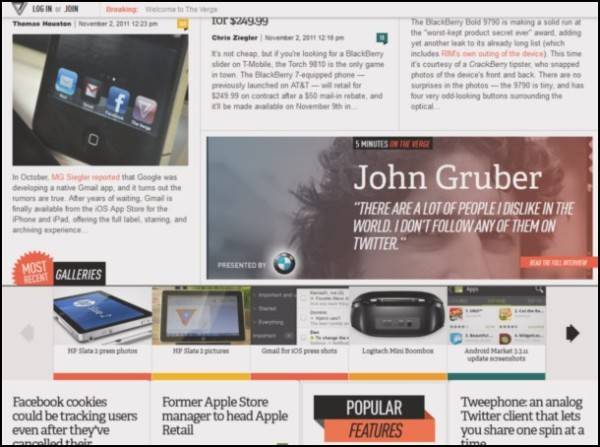I’ll start with my disclaimer up front: These are my opinions you’re about to read, not necessarily those of ReadWriteWeb. Now, maybe you’ve noticed this yourself already, but I actually don’t read much “tech news” on the Web on a regular basis, besides what we publish here and what some friends and colleagues of mine produce elsewhere daily. There is news about technology and there is “tech news,” and most of the time, they come from separate planets.

Many a colleague and some regular readers have read from me, or heard me say, the following: If a pro sports site like ESPN.com were to turn its attention to producing a technology news publication, it could improve the genre immensely. This week, the sports-minded folks at SB Nation are proving me right by providing a new and better platform for Joshua Topolsky and company to produce The Verge, the successor to Topolsky’s version of Engadget.
I did not read Engadget regularly, or because I wanted to, and I still don’t. No one’s fault, really. I’m on record as not caring much for the blog format for publishing. If the new Web is to assume the place of old media in the hearts as well as the minds of its readers, it needs to produce something of style, something with personality, with charisma and without this self-adhesive sense of entitlement that propagates among blogs like oil slicks.
So I told myself to give The Verge a chance. And before I start madly taking it apart like some piece of hardware I might be reviewing, and before I start whining about something stupid like how much the writers whine about stupid stuff, I think it’s only fair to go on record with what I like about it so far.
1. It’s self-contained. What I dislike about blogs is their lack of tangibility. A long scroll of tear-off story sheets is no more endearing than a roll of paper towels, or a roll of something else. But a magazine, in the days of Byte and Creative Computing, was something you could hold. It had weight, and that gravity lent it some tangible value. No single Web publication can duplicate that same formula without paper and ink, but it can try to build a new formula with new and old components blended together, that has a similar result. Verge’s halftone-shaded tiles with sharp headings and regular, conservative use of white space finally reintroduces typography to the Web publication. Typography is what substitutes for voice, timbre, theme music — all the elements that used to make TV news programs (back when TV made news programs) worth watching.

2. Some stories are more perennial than others. At last, features with longer shelf life are granted longer life, and don’t fall off the bottom of the conveyor belt along with everything else. Notice how The Verge’s front page is gently paginated, with subsections divided from one another by standout bridges that can scroll horizontally. I want to read The Verge more than I want to read a blog; what I see makes it as interesting as what I read.
3. Different classes of articles are treated with class. On the average blog, an article is an article is an article. What used to sell a magazine was the stature, prominence, and often elegance of its features. With The Verge, you can tell which are the features and which is the regular news. Not that the regular news is reduced in importance, but rather it’s given its own class. Restaurants serve main courses, side dishes, and desserts. They don’t clump everything together into one box and serve it to you on a moving escalator. The Verge throws away the one-course-cafeteria model, and gives me visual reasons to become interested in the material.
In the absence of typography, class, style, and other distinguishing elements, many other blogs have relied upon other traits and characteristics to promote themselves and make you want to read their toilet paper over someone else’s. Pomposity, arrogance, and self-righteousness are often paraded before the public with pride, and with surprisingly positive effects. Historically, nearly every “old media” baron started her or his career as a “new media” maverick. In fact, that’s the key distinguishing feature: Every one of them starts a revolution, only to become the one who’s overthrown (see “Kane, Citizen” for the template). When there’s no other reason to read or watch or listen, the appearance of revolution keeps the audience occupied.
The Verge has less room for false superiority, and at least right now, has no excuse to make room. With the tools SB Nation has given it, The Verge has the opportunity to do for the Web what magazines used to do for the world. I can’t speak for whether Topolsky and his team will make full use of that opportunity, but he has no good reason not to.










